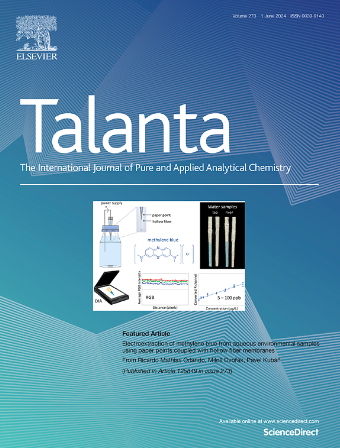A mixed-organic ligands Ru(bpy)32+@Zn mMOFs-NH2 nanoreactors integrated co-reaction accelerator and morphologic regulator for the electrochemiluminescence detection of ATP
IF 5.6
1区 化学
Q1 CHEMISTRY, ANALYTICAL
引用次数: 0
Abstract
The functionalized architecture within the nanoreactor could dramatically change the electron transport and reaction efficiency of ECL during electrochemical processes. Here, we've devised a novel mixed-ligand strategy that combines co-reaction accelerator and morphologic regulator onto the same metal node. This innovative approach effectively addressed the critical issue that some co-reactants cannot be covalently linked due to their special states, while enhancing the stability and electroactivity of MOFs nanoreactors. Ru(bpy)32+ was in-situ encapsulated within Zn mMOFs-NH2 nanocages in which the 2-aminoterephthalic acid (NH2-BDC) ligand functioned as an effective co-reaction accelerator. While S2O82− underwent electron exchange on the surface of GCE to form SO4•−, Zn mMOFs-NH2 was electrochemically oxidized to Zn mMOFs-NH•, which could significantly catalyze S2O82− to form SO4•−. This greatly increased the local concentration of SO4•− in the vicinity of Ru(bpy)32+, thus achieving self-enhancing ECL. At the same time, 1,4-benzenedicarboxylic acid (BDC) ligands were used as morphologic regulator, yielding ultra-thin MOFs nanosheets that significantly boosted the loading capacity for Ru(bpy)32+ and enhanced electrical conductivity. The luminous efficiency of Ru(bpy)32+ is further enhanced by this synergy. A highly sensitive ECL biosensor was crafted for the detection of ATP. Optimal conditions allowed a robust linear correlation between the ECL intensity and the logarithm of ATP concentration, enabling a sensitive detection limit down to 1.18 nM. Our findings underscore the exceptional self-enhanced ECL properties of the devised Ru(bpy)32+@Zn mMOFs-NH2 nanoreactors, presenting a novel and promising platform for biomolecular analysis.

一种混合有机配体 Ru(bpy)32+@Zn mMOFs-NH2 纳米反应器,集成了共反应加速器和形态调节器,用于 ATP 的电化学发光检测。
纳米反应器内的功能化结构可在电化学过程中显著改变 ECL 的电子传输和反应效率。在这里,我们设计了一种新颖的混合配体策略,将共反应加速剂和形态调节剂结合到同一个金属节点上。这种创新方法有效地解决了某些共反应物因其特殊状态而无法共价连接的关键问题,同时提高了 MOFs 纳米反应器的稳定性和电活性。Ru(bpy)32+ 被原位封装在 Zn mMOFs-NH2 纳米笼中,其中的 2-aminoterephthalic acid (NH2-BDC) 配体可作为有效的共反应加速器。S2O82- 在 GCE 表面进行电子交换生成 SO4--,而 Zn mMOFs-NH2 则被电化学氧化为 Zn mMOFs-NH-,后者能显著催化 S2O82- 生成 SO4--。这大大提高了 Ru(bpy)32+ 附近 SO4-- 的局部浓度,从而实现了自增强 ECL。同时,1,4-苯二甲酸(BDC)配体作为形态调节剂,产生了超薄的 MOFs 纳米片,大大提高了 Ru(bpy)32+ 的负载能力,并增强了导电性。这种协同作用进一步提高了 Ru(bpy)32+ 的发光效率。为检测 ATP 制作了一种高灵敏度的 ECL 生物传感器。在最佳条件下,ECL 强度与 ATP 浓度的对数之间呈稳健的线性相关,使灵敏检测限低至 1.18 nM。我们的研究结果表明,所设计的 Ru(bpy)32+@Zn mMOFs-NH2 纳米反应器具有卓越的自增强 ECL 特性,为生物分子分析提供了一个新颖且前景广阔的平台。
本文章由计算机程序翻译,如有差异,请以英文原文为准。
求助全文
约1分钟内获得全文
求助全文
来源期刊

Talanta
化学-分析化学
CiteScore
12.30
自引率
4.90%
发文量
861
审稿时长
29 days
期刊介绍:
Talanta provides a forum for the publication of original research papers, short communications, and critical reviews in all branches of pure and applied analytical chemistry. Papers are evaluated based on established guidelines, including the fundamental nature of the study, scientific novelty, substantial improvement or advantage over existing technology or methods, and demonstrated analytical applicability. Original research papers on fundamental studies, and on novel sensor and instrumentation developments, are encouraged. Novel or improved applications in areas such as clinical and biological chemistry, environmental analysis, geochemistry, materials science and engineering, and analytical platforms for omics development are welcome.
Analytical performance of methods should be determined, including interference and matrix effects, and methods should be validated by comparison with a standard method, or analysis of a certified reference material. Simple spiking recoveries may not be sufficient. The developed method should especially comprise information on selectivity, sensitivity, detection limits, accuracy, and reliability. However, applying official validation or robustness studies to a routine method or technique does not necessarily constitute novelty. Proper statistical treatment of the data should be provided. Relevant literature should be cited, including related publications by the authors, and authors should discuss how their proposed methodology compares with previously reported methods.
 求助内容:
求助内容: 应助结果提醒方式:
应助结果提醒方式:


